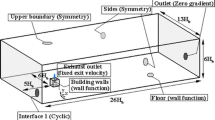Abstract
Air entrainment is known to be one of efficient and inexpensive methods to prevent cavitation damages in hydropower projects. The shape of sudden expansion-fall is used as a common device for mitigating cavitation erosions. The complex flow patterns with cavitation are numerically simulated by using the realizable k - ε turbulence model and the air-water mixture model. The calculated results are compared well with the experimental results as well as those obtained with the k - ε turbulence model with the Volume Of Fluid (VOF) Model. The calculated results agree well with the experimental data for the aeration cavity and wall pressure. Moreover, the air concentration near sidewall is simulated by a mixture model. It is found that the mixture turbulence model is superior to the VOF turbulence model.
Similar content being viewed by others
References
PFISTER M., HAGER W. H. Deflector-generated jets[J]. Journal of Hydraulic Research, 2009, 47(4): 466–475.
PFISTER M., HAGER W. H. Chute aerators. I: Air transport characteristics[J]. Journal of Hydraulic Engineering, 2010, 136(6): 352–359.
PFISTER M., HAGER W. H. Chute aerators. II: Hydraulic design[J]. Journal of Hydraulic Engineering, 2010, 136(6): 360–367.
ANDO T., SHAKOUCHI T. Flow characteristics over forward facing step and through abrupt contraction pipe and drag reduction[J]. Res. Rep. Fac. Eng. Mie. Univ., 2004, 29: 1–8.
YANG Qing, ZHANG Jian-min and DAI Guang-qing. Influence of gas nucleus on scale effect of cavitation[J]. Journal of Hydroelectric Engineering, 2005, 24(3): 75–77 (in Chinese).
NIE Meng-xi, DUAN Bing and LI Lin-lin. Hydraulic characteristics a long the sidewall of a sluice down stream of a sudden lateral enlargement and vertical drop[J]. Journal of Tsinghua University (Science and Technology), 2006, 46(12): 1969–1972 (in Chinese).
NIE Meng-xi, WU Guang-hao and WANG Xiao-ming. Effect of lateral deflector on lateral and bottom cavity lengths[J]. Journal of Hydraulic Engineering. 2002, (5): 91–96 (in Chinese).
LIU Chao, ZHANG Guang-ke and ZHANG Guang-bi et al. Analysis on length of air cavity of lateral aerators[J]. Journal of Hydroelectric Engineering, 2007, 26(5): 112–115 (in Chinese).
LIU Chao, YANG Yong-quan and DENG Jun. Experimental study on air entrainment to alleviate cavitations for downstream sidewall of ogre-section in spillway tunnel[J]. Journal of Hydrodynamics, Ser. A, 2006, 21(4): 465–472 (in Chinese).
WU Wei-wei, WU Jian-hua and RUAN Shi-ping. Study of the geometries of aerators for flat-bottomed discharge tunnels[J]. Journal of Hydrodynamics, Ser. A, 2007, 22(4): 397–402 (in Chinese).
KARIM O. A. K., MALI K. H. M. Prediction of flow patterns in local scour holes caused by turbulent water jets[J]. Journal of Hydraulic Research, 2000, 38(4): 279–287.
XU Wei-lin, LIAO Hua-sheng and YANG Yong-quan et al. Numerical simulation of 3-D turbulent flows of plunge pool and energy dissipation analysis[J]. Journal of Hydrodynamics, Ser. A, 1996, 11(5): 561–569 (in Chinese).
WANG Kun, JIN Sheng and LIU Gang. Numerical modeling of free-surface flows with bottom and surface-layer pressure treament[J]. Journal of Hydrodynamics, 2009, 21(3): 352–359.
WU Jian-hua, AI Wan-zheng. Flows through energy dissipaers with sudden reduction and sudden enlargement forms[J]. Journal of Hydrodynamics, 2010, 22(3): 360–365.
CHEN Jian-gang, ZHANG Jian-min and XU Wei-lin et al. Numerical simulation investigation on the energy dissipation characteristics in stilling basin of multi-horizontal submerged jets[J]. Journal of Hydrodynamics, 2010, 22(5): 732–741.
Zhang Ting, Wu Chao and Lu Hong et al. 3-D numerical simulation of flow on stepped spillway combined with X-shape flaring gate piers[J]. Journal of Hydraulic Engineering, 2004, (8): 15–20.
CHEN Qun, DAI Guang-qing and LIU Hao-wu. Volume of fluid model for turbulence numerical simulation of stepped spillway overflow[J]. Journal of Hydraulic Engineering, 2002, 128(7): 683–688.
CHENG Xiang-ju, CHEN Yong-can and LUO Lin. Numerical simulation of air-water flow on stepped spilliway[J]. Science in China Series E: Technological Sciences, 2006, 36(11): 1355–1364.
CHENG Xiang-ju, LUO Lin and ZHAO Wen-qian. Numerical simulation of characteristics of free-surface aeration on stepped spillway[J]. Journal of Hydrodynamics, Ser. A, 2004, 19(2):152–157 (in Chinese).
QIAN Zhong-dong, HU Xiao-qing and HUAI Wen-xin. Numerical simulation and analysis of turbulent flow over stepped spillways[J]. Science in China Series E: Technological Sciences, 2009, 39(6): 1104–1111 (in Chinese).
CHEN Da-hong, LI Wei. Investigation of numerical simulation methods on free surface flow[J]. Journal of Hydrodynamics, Ser. A, 2001, 16(2): 36–54 (in Chinese).
SHIH T. H., LIOU W. W. and SHABBIR A. et al. A new k - ε eddy-viscosity model for high Reynolds number turbulent flows-model development and validation[J]. Computs and Fluids, 1995, 24(3): 227–238.
Author information
Authors and Affiliations
Corresponding author
Additional information
Project supported by the Key Science Foundation of Ministry of Education of China (Grant No. 2008108111), the National Basic Research Program of China (973 Program, Grant No. 2007CB714105) and the Program of New Century Excellent Talents in University (Grant No. NCET-08-0378).
Biography: ZHANG Jian-min (1972-), Male, Ph. D., Professor
Rights and permissions
About this article
Cite this article
Zhang, Jm., Chen, Jg., Xu, Wl. et al. Three-Dimensional Numerical Simulation of Aerated Flows Downstream Sudden Fall Aerator Expansion-In a Tunnel. J Hydrodyn 23, 71–80 (2011). https://doi.org/10.1016/S1001-6058(10)60090-X
Received:
Revised:
Published:
Issue Date:
DOI: https://doi.org/10.1016/S1001-6058(10)60090-X




